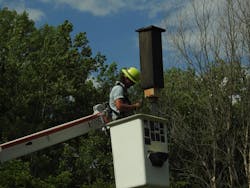Ameren Illinois "Plants" Poles to Attract Endangered Bats
Outside of learning that Bruce Wayne was secretly Batman, what do we really know about bats?
Ameren Illinois electric supervisor Ryan Weder and linemen from the company's Mattoon Operating Center certainly know more than most of us after "planting" habitat for the nocturnal flying mammals in Warbler Ridge Conservation Area just south of Charleston, Illinois.
The conservation area managed by Grand Prairie Friends, a non-profit conservation land trust, is about 1,000 acres along the Embarras River in central Illinois. A renewable energy company partnered with Grand Prairie Friends four years ago to transform a 165-acre parcel of land with native hardwood trees and pollinator plants in hopes of attracting bats. To assist with creating some roosting areas, Weder's team was called to help with the "planting" of the 25-ft-tall manmade bat structures.
The "planting" Weder and the linemen performed was to set used cedar power poles in two different locations within the conservation area. The linemen, who volunteered their time after hours, also attached the artificial bark known as Brandenbark at the tops of the poles.
"This was definitely a first for me and the linemen," Weder says. "We volunteer and assist different groups throughout the year but when (Grand Prairie Friends director) Sarah Livesay called me to ask for used poles and assistance in setting them to create roosting areas for bats, I said, 'yes,' but needed to learn more."
What Weder and the linemen quickly learned was Grand Prairie Friends and researchers from the Illinois Bat Conservation Program discovered two distinct bat populations at Warbler Ridge – the Indiana Bat, which is listed as federally endangered, and the Northern Long-Eared Bat, which is federally threatened.
"It took a couple of years for the bats to find the manmade roosting areas, but today we see hundreds of bats using these pods," Hohoff says. "It's incredible. It usually takes many years for the bats to find artificial roosts. The success we saw right of way was kind of unprecedented and neat to see."
"It is exciting to see an endangered bat using the bat pods," says Jill Maes, Natural Areas and Operations Technician with Grand Prairie Friends. "It proves that we are trying to help the population thrive versus ignoring the bats."
Hohoff says bats tend to have a misunderstood reputation and people can be afraid of them, but bats are important to the ecosystem.
"Bats are really important for the ecosystem and especially here in central Illinois for agriculture, "Hohoff says. "Bats help control the insect population. They eat corn earworm and larvae and mosquitos you see in your backyard."
Ameren Illinois surprised Grand Prairie Friends in mid-September when visiting the site to check on the bats wellbeing. Weder along with Electric Operations Director Ron Juarez and Community Relations Executive Karly Combest presented the non-for-profit group with a $5,000 check.
For more information about Grand Prairie Friends, visit grandprairiefriends.org; and to learn more about Ameren Illinois' biodiversity efforts, visit AmerenIllinois.com



